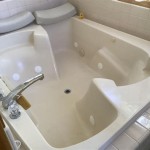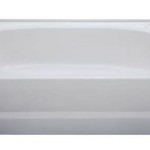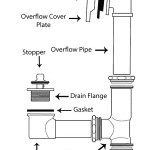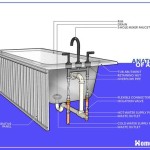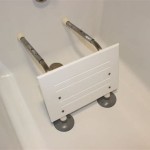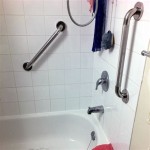Narrow Bathtub Dimensions: A Comprehensive Guide
The selection of a bathtub involves careful consideration of bathroom space, personal preferences, and functional needs. In situations where space is limited, particularly in smaller bathrooms or when remodeling with existing constraints, a narrow bathtub becomes a practical and often essential solution. Understanding the dimensions of narrow bathtubs, their variations, and the factors that influence their selection is crucial for homeowners, contractors, and interior designers.
Narrow bathtubs are designed to maximize space utilization without compromising the bathing experience entirely. These tubs typically prioritize length and depth while minimizing width. This design allows for a comfortable soak while freeing up valuable square footage in the bathroom.
Understanding Standard Bathtub Dimensions vs. Narrow Bathtub Dimensions
To appreciate the benefits of narrow bathtubs, it's helpful to first understand the dimensions of standard bathtubs. A typical standard bathtub measures around 60 inches in length, 30 inches in width, and 14-16 inches in depth. These dimensions offer a comfortable bathing space for most individuals. However, in smaller bathrooms, a 30-inch width can take up a significant portion of the room, potentially hindering movement and design options.
Narrow bathtubs, conversely, are characterized by their reduced width. While the length typically remains similar to a standard bathtub (around 60 inches), the width can range from 25 inches to even as narrow as 20 inches in some models. This reduced width allows for a more streamlined fit in tight spaces. The depth, while important for soaking comfort, is often similar to standard tubs, maintaining a sufficient water volume for a relaxing bath.
The specific dimensions of a narrow bathtub can vary depending on the manufacturer, design, and style. It's essential to consult the product specifications before making a purchase to ensure the tub will fit the intended space and meet the user's needs.
Key Considerations When Choosing a Narrow Bathtub
Several factors should be considered when selecting a narrow bathtub to ensure a suitable and functional fit. These considerations go beyond simply measuring the available space and encompass aspects of user comfort, installation requirements, and overall bathroom design.
Bathroom Layout and Space Restrictions: This is the primary driver for choosing a narrow bathtub. The available space in the bathroom dictates the maximum dimensions the bathtub can occupy. Accurately measuring the bathroom and considering the placement of other fixtures, such as toilets, sinks, and showers, is crucial. The layout should allow for comfortable movement around the tub and prevent any obstruction of doorways or other essential elements.
User Comfort and Accessibility: While narrow bathtubs are designed to save space, it's important to ensure they provide adequate comfort for the user. Consider the height and build of the individuals who will be using the tub. If the tub is too narrow, it might feel cramped and uncomfortable. Furthermore, accessibility should be a prime consideration. If the user has mobility issues, features like grab bars or a low step-over height can significantly improve safety and usability.
Material and Style: Bathtubs are available in a variety of materials, each offering different characteristics in terms of durability, heat retention, and aesthetics. Acrylic tubs are lightweight and relatively inexpensive, while cast iron tubs are known for their durability and excellent heat retention. Steel tubs are another option, offering a balance between cost and performance. The style of the bathtub should complement the overall design of the bathroom. Options include alcove tubs, drop-in tubs, and freestanding tubs. The chosen style should integrate seamlessly with the existing or planned décor.
Plumbing and Installation Requirements: Installing a bathtub involves connecting it to the existing plumbing system. Consider the location of the water supply and drain lines. If the plumbing needs to be relocated, it can add to the overall cost and complexity of the installation. Ensure the chosen bathtub is compatible with the existing plumbing configuration. It is generally recommended to consult with a qualified plumber to assess the plumbing requirements and ensure a proper installation.
Budget: The cost of a narrow bathtub can vary depending on the material, style, and brand. Establish a budget before beginning the selection process to avoid overspending. Consider not only the cost of the bathtub itself but also the cost of installation, plumbing modifications, and any necessary accessories, such as faucets and drain hardware.
Types of Narrow Bathtubs
Narrow bathtubs are available in various configurations to suit different bathroom layouts and design preferences. Understanding the different types of narrow bathtubs can help in making an informed decision.
Alcove Bathtubs: Alcove bathtubs are designed to fit into a three-walled recess, making them a popular choice for smaller bathrooms. Narrow alcove bathtubs offer the same space-saving benefits while still providing a comfortable bathing experience. These are often the most readily available and affordable options for narrow tubs.
Drop-In Bathtubs: Drop-in bathtubs are installed into a pre-built frame or enclosure. This allows for greater flexibility in terms of design and customization. Narrow drop-in bathtubs can be incorporated into a custom bathroom design to create a unique and space-efficient bathing area.
Corner Bathtubs: Corner bathtubs are designed to fit into the corner of a bathroom, maximizing space utilization. While not all corner bathtubs are narrow, some models are specifically designed with a reduced width to fit into tight spaces. These tubs can add a stylish and functional element to a smaller bathroom.
Freestanding Bathtubs: Freestanding bathtubs are not connected to any walls and can be placed anywhere in the bathroom. Narrow freestanding bathtubs can create a focal point in the bathroom while saving space. These tubs offer a modern and luxurious look, but require careful planning of plumbing and positioning.
Walk-In Bathtubs: While walk-in bathtubs are primarily designed for accessibility, some models are available in narrower widths. These tubs feature a door that allows users to enter and exit the tub without stepping over a high threshold, making them ideal for individuals with mobility issues. Considering a walk-in narrow tub can be a crucial consideration for aging in place renovations.
Japanese Soaking Tubs (Ofuro): Inspired by traditional Japanese bathing practices, Ofuro tubs are typically deeper and shorter than standard bathtubs. While they might not be traditionally "narrow", their smaller footprint compared to standard-sized tubs effectively saves space. They focus on a seated soaking experience, offering a different approach to relaxation and hygiene. Consider these if a deep, upright soaking experience is desired over a reclining one.
Materials Used in Narrow Bathtub Construction
The material of a bathtub significantly impacts its durability, heat retention, and overall aesthetic. Several materials are commonly used in the construction of narrow bathtubs, each with distinct advantages and disadvantages.
Acrylic: Acrylic is a popular choice for bathtubs due to its affordability, lightweight nature, and ease of maintenance. Acrylic bathtubs are resistant to chipping and cracking, and they offer good heat retention. They are also available in a wide range of colors and styles. However, acrylic bathtubs can be prone to scratching and may not be as durable as some other materials.
Cast Iron: Cast iron bathtubs are known for their exceptional durability and heat retention. They are heavier than acrylic tubs but can last for many years with proper care. Cast iron bathtubs are typically coated with enamel, providing a smooth and glossy finish. However, they can be more expensive than acrylic tubs and may require professional installation due to their weight.
Steel: Steel bathtubs are a more affordable alternative to cast iron. They are lighter than cast iron but still offer good durability. Steel bathtubs are typically coated with porcelain enamel, providing a smooth and durable surface. However, they may not retain heat as well as cast iron tubs and can be prone to chipping if not properly maintained.
Copper: Copper bathtubs offer a unique and luxurious look. They are known for their excellent heat retention and natural antibacterial properties. Copper bathtubs are durable and can last for many years with proper care. However, they are typically more expensive than other types of bathtubs and may require specialized cleaning products.
Fiberglass: Fiberglass bathtubs are lightweight and inexpensive. However, they are less durable than other materials and can be prone to cracking and fading. Fiberglass tubs are often reinforced with acrylic for added strength and durability.
Installation Considerations for Narrow Bathtubs
Proper installation of a narrow bathtub is crucial to ensure its functionality, longevity, and safety. The installation process typically involves several steps, including preparing the space, connecting the plumbing, and securing the tub in place.
Space Preparation: Before installing the bathtub, ensure the space is properly prepared. This includes removing any existing fixtures, cleaning the area, and ensuring the floor is level. Any necessary plumbing modifications should be completed before installing the tub.
Plumbing Connections: Connect the bathtub to the water supply and drain lines. Ensure all connections are secure and leak-free. It is generally recommended to use flexible supply lines for easier installation and to allow for some movement of the tub.
Leveling and Securing: Level the bathtub and secure it in place according to the manufacturer's instructions. This may involve using shims to adjust the height and securing the tub to wall studs or the floor. Proper leveling is essential to ensure proper drainage and prevent water from pooling.
Sealing: Seal the edges of the bathtub where it meets the wall or floor with caulk. This will prevent water from seeping behind the tub and causing damage. Use a high-quality caulk that is specifically designed for bathroom use.
Testing: After installation, test the bathtub for leaks. Fill the tub with water and check for any signs of leakage around the drain, supply lines, and seams. If any leaks are detected, address them immediately.

Standard Bathtub Dimensions And Sizes By Type 2024 Guide

What Size Is A Small Bath Ideal Baths For Bathrooms

60 Inches Or Less Bathtubs 11 Small For Bathrooms

Small Bathtubs Under 5

Bootzcast Drawing Bathroom Dimensions Small Bathtub

Small Bathtubs Under 5

Audrey Prestige Bathtub Classic Look Simple Elegant Best Ing Tub Hdb Favourite Singapore Bathtubs

5 Skinny Bathtubs Important For Tight Bathroom Spaces Irwin Weiner Interiors

Looking For The Perfect Bathtub Your Bathroom Remodel We Break Down Options Sizes Dimensions Tub

Small Freestanding Tub 47 X 27 Rectangular Bathtub Sizes

